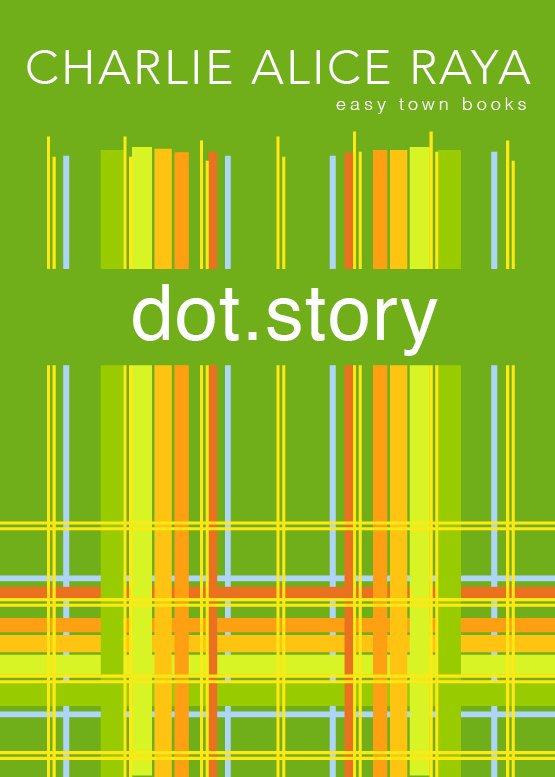preview, dot.story
Bruno, Buenos Aires, Argentina
Some five years ago, Bruno was one of the first to get a dot.customer account. It was partly curiosity about this new company, partly his love for contradictory dress choices, partly his obsession with finding flaws.
What surprised him back then was that dot. valued his emails and sent him vouchers whenever they acted on one of his remarks. One time he found a pretty critical bug with a payment option, and they called him to ask whether he wanted a big check or a pack of vouchers. Another time he sent them a suggestion that would make it even easier to personalise a customer’s dot.profile, and in return they offered him a job. But he had a great job as a gardener for the city, and he liked his little dot. hobby. He liked to be on the outside and to look in at times.
Today was Bruno’s birthday.
He was going to celebrate it with a shopping spree on dot. It was time to use up some more of his vouchers, anyway.
After breakfast in bed, Bruno dressed up in a dark blue silk button shirt and added a loose yellow tie, and red underpants. It was too hot to wear trousers. As for a skirt, he only had a tight leather skirt that didn’t quite fit any more. He should find something new, something more contradictory anyway. Anyone could do shirt and skirt.
Bruno placed a bottle of water, a freshly brewed coffee, and some birthday cookies next to his monitor and settled in his comfy swivel chair. Yes, today was going to be a good day.
Bruno liked to start his dot. sessions as a stranger. That meant visiting the dot.website without logging in, and taking a look at which designers and suppliers had joined the dot.networks, which new designs or categories had been added, and what news had been published.
The news stories were always interesting and often fun, like the story about a revolutionary washing powder from Pori in Finland, which had been developed during a party in a hot tub.
Or the story from the dot.station in Gdańsk, Poland, who were testing a clothing service for hikers and water sports people who could rent everything they needed in Gdańsk, before starting on their tour along the coast of the Baltic Sea. This dot.station was also developing an idea in cooperation with the dot.station in Kaliningrad, to offer a tour between the two cities with an all-round clothing service. Though politics were presently putting a hold on that idea.
Or the story from the dot.station in London which extended their station to give local small businesses a new home. These businesses had been forced from their former workshops due to the crazy property prices in the city. So now, an instrument builder, a bespoke globes producer, a potter, and a shoe maker had a new home at the dot.station. This extension of the dot.station led to some other extensions: a music pavilion for small concerts and instrument lessons, an outdoor exhibition of globes in the dot.station’s main garden, a shop for handmade pottery and glassware, plus pottery classes at the dot.station’s primary school, and a new section for shoes in the dot.showroom.
This was something Bruno liked about dot. They always sought ways to intertwine what they had with what was added. They never stopped to search for synergies.
In fact, they always sought to connect the dots.
Bruno chuckled and took a sip of his coffee. Another story was about the talks between dot.international and the Apache in New Mexico, US, to determine where another dot.station might be of the greatest value to the Apache community. There was talk about including a tailors and designers training centre for people from around the world who wanted to learn from the Apache.
In another story, a new designer, Esin from Jalalabad in Afghanistan, wrote about how she interwove her designs with elements inspired by Afghan poetry. Bruno wasn’t into poetry. He didn’t really get it. But he was strangely touched by the beautiful designs which seemed more alive because of their connection to the world of words.
Another story reported that the dot.station near Tunis, which also included the dot.headquarters, added an area with wells and palm trees for nomads who might want to pass through.
Bruno wished, he was a traveller. But he was afraid of flying, and there was no way he would ever step on board of a ship. As for cars, he could do it, but only if there was no other way.
Maybe this was another reason why he loved dot. dot. was about the whole world, about everyone. He could probably write to them and say, look I’m a scared guy from Buenos Aires who lives next to the gardens where he works, who has his food delivered and who doesn’t dare to go outside his pretty small mobility radius. Couldn’t they invent some special clothes for him?
Bruno was sure, they would come up with something. He just didn’t want them to know about his anxieties. But as soon as he asked them, they would know. Maybe he could ask for a friend who was a bit of a scared kid, and are there any designs to— to what? He was OK with his life. Other people were worried. But he was OK. And through dot. he could sort of travel a bit, take part from the outside. Take an interest in when the first nomads arrived, or when the next concert would be at the London dot.station, or watch Esin’s next fashion show. Apparently there would be recordings of all three events.
Bruno clicked on a story about the plans for dot.city in Aotearoa New Zealand.
Now dot.city …
Maybe he could find a doctor who would be prepared to drug him for the flight and only wake him up in front of the gates of dot.city.
dot.city was supposed to become absolutely fantastic — a whole city where almost everyone was, in one way or another, working on something that had a relation to clothing.
It had taken the dot.international team two years to convince the government of Aotearoa New Zealand that dot.city was a good idea. And it took them another two years to finalise the construction plans. From January on, the building site was to be cleared and prepared for the building and planting phase. And the article said that dot.city would have over thirty gardens.
What a dream.
Bruno sighed (…)
Bruno clicked on a story headlined: ‘Dignity can be a question of the right size.’ The writer, Mitch, was an author and a dwarf, from Chicago, US, who wrote: ‘I always believed that dignity can be a question of the right size. In fact, this line has crossed my mind whenever I had to do my shopping for clothes in the children’s section. But it was only when I entered a dot.customer area and was treated like an adult by a professional tailor while trying on my purchases from the dot.website, which fitted perfectly, that I fully grasped the truth of these words. I literally left the dot.customer area a full man, and I want to thank the dot.designers, dot.international and the wonderful people at my local dot.station for making that possible. I would also like to point out that dot.’s collections for dwarfs are great, and I for one am happy that the dot.designers always have an open ear for what a customer might be interested in, no matter whether they are dwarfs or giants or bigs or slims or mediums.’
After that the writer went into more details about the art of dressing, and he wrote that he would soon start a column for dot.press with observations about size and style.
Bruno scratched his chin, a thought was taking shape. So a dwarf … Hm.
Bruno took another sip of his coffee and logged into his dot.profile.
In the early days of dot. the customer profile had been more promise than actual feature. You would log in and go through a number of settings so that only items in your size and only items matching the preferences you chose to be relevant, would be displayed. And that was basically it.
By now, the dot.customer profile was a dream, and you could literally do with it whatever you wanted, or make it do whatever you wanted.
Bruno’s father had only one page that showed his father’s favourite shirts, trousers, socks and underwear, all pretty classic everyday wear, all usually available without delay.
Bruno’s father ordered some of those items about once a year. And that was it. His father wasn’t interested in anything else, but he loved the fact that he could log in once a year, and his things (as he called them) were still there, and his father only had to click a few times, and usually some days later, he got his delivery, and the delivery person collected his old clothes for the recycling workshop.
Bruno’s dot.customer profile was — well, the opposite. He used a desktop display on his first page which had forty-eight icons, so far. Moreover he could sort these icons manually.
Some of the icons were linked to former searches, others were linked to designers he liked, another to fashion show videos, another was a shortcut to the open-gender filter, one of Bruno’s favourites, one link opened a communications page where customers could connect with each other, and post photos, videos, comments, or chat, another icon was linked to a page with Bruno’s favourite dot.articles, another was linked to the customer contribution channel and so on.
Bruno scratched his chin again. The dwarf … Hm.
Bruno knew that his searches were anonymous and that no one could see what he saved in his profile, but he still hesitated.
And yet, he was curious.
Inhaling, he clicked on the icon for a start from scratch search.
This search allowed him to enter keywords and refine the research results by adding or excluding keywords — really like it used to be on the internet before the internet got smart and filled loads of blanks it had no business with filling.
Bruno sighed. He felt a little moody. But if a dwarf could get what he needed, why shouldn’t Bruno?
Bruno exhaled and started to type: I am afraid of people, transport, distances, everything that isn’t familiar. I can’t be close to people. I am OK with that. But I would like to feel more courageous nonetheless. More free to move around. Maybe.
Bruno clicked on search.
Gradually a little smile appeared on his face as the search symbol kept blinking for over three minutes.
Bruno wondered whether a real person was looking at this request, or whether the blinking was only there to make him feel better. After all, there is nothing worse than an immediate answer to something that is a big issue for you.
And then Bruno laughed.
The search came back with questions.
And that is the most respectful way to address anyone’s big issues apart from sending them ice cream.
The questions were:
How much distance do you need to feel comfortable with other people?
How do you feel about tight clothes?
How do you feel about loose clothes?
What kind of shoes do you like?
What kind of materials do you like?
Is there someone you would call a hero?
While Bruno answered the questions, more questions came in, and at some point he was informed that a real person had taken over to assist him in his search.
After about an hour, the first search results were displayed.
And they puzzled Bruno.
By the time, he had answered the last question, he had expected nothing short of a bulletproof armour sending off shock waves if anyone came too close.
Instead the top results displayed some twelve jackets with something like an inbuilt frame, like skirts used to have centuries ago. He didn’t know what they were called. And these frames would make sure that no one could get close to him.
The assistant explained that Bruno’s dot.workshop could fine-tune the jacket to make sure the jacket expanded to how much distance Bruno needed.
‘But how do I get through my front door?’ Bruno wrote back.
‘It works a bit like an umbrella, you pull a string and the jacket slowly folds so that you can get through doors, pull again and the frame expands again.’
Bruno felt tired, and decided to take a break. He thanked the assistant, saved his search and went to his sofa.
Some hours later, and after a light meal, Bruno returned to his computer.
He was still logged into his dot.profile, clicked on the open-gender filter and chose the mix-dress-with-suit sub-filter plus blue and red.
The results were great, with many new additions from various designers, and since Bruno had so many vouchers, he chose two complete outfits, or head to toe outfits, as they were also called. One outfit was by a dot.designer from Quito in Ecuador, and the other by a dot.designer from Sanaa in Jemen. And he marked the designer from Sanaa as someone to keep an eye on.
Next Bruno went to the filters overview, chose profession, then gardener and added: love lilies, something for hot days that can get dirty. Again, the results made him smile broadly, and again he chose two outfits. One outfit by a dot.designer from Zagreb, Croatia, and the other by a dot.designer from Chiang Mai, Thailand.
Finally, Bruno returned to his earlier search which he had saved under: anxiety armours, and this time he took a look at the other search results. There were some other umbrella designs, as he called them in his mind, some expanding trousers and skirts, but somehow he felt that the jacket would make him feel safest. Other suggestions focused on courage and tended to make you look like a king or a warrior. Courage boosters, he called those. But was that all it took? Look like a warrior and your courage will kick in?
There were also suggestions that looked like any other jumper or trousers, but apparently those items had inbuilt stabilisers, giving the wearer the sensation that they were protected. Inside armour, Bruno coined those. But he wasn’t sure that any of those would be something for him.
No, if he was to go down this road at all, then he would start with the crazy. No. Not crazy. But with the ideas that clearly stated for everyone to see that he just couldn’t abide people near him.
Bruno browsed the keep-distance jackets and hesitated again. Would he really ever wear such a jacket? Would he find the courage to take it outside, to open it? And should he choose a red version to make his point extra loudly, or should he go for the blue jacket to kind of signal that this wasn’t personal? So to speak.
Bruno clicked on a blue keep-distance jacket designed by Paul from Boscastle in England.
In the design background section, Paul wrote that his cousin’s anxieties inspired him to create something that would make his cousin’s life more enjoyable. It hadn’t been easy to figure out the details, and in the end, building the prototype was a cooperation between three designers, Paul from England, Handan from Turkey, and Jorge from Mexico.
Paul added that he was glad that thanks to dot., the jackets were finally available around the world.
Bruno inhaled.
Should he do it?
Should he buy the jacket?
But why not?
Yes, he would have to go to the dot.station and face someone who could fine-tune the jacket. And then they would know. They would know that the jacket really was for him.
Hm.
Bruno clicked on buy and exhaled. Then he clicked on the link for his shopping list to see all his purchases. Next to each item was the order status. Two of the other outfits were about to go into production, one would probably get to the required order volume within a week or two, and one was still pretty new and might take some weeks before it got enough orders for the local dot.station.
With the blue jacket he had to decide whether to place a single order, or whether he wanted to wait until more customers ordered this jacket.
Bruno clicked on single order. He didn’t want to wait. Waiting would only make him more nervous.
Charlie Alice Raya
dot.story
Edinburgh, Tunis and the world
A story illustrating the ideas for dot.
Pages: 70k, 230 pages
Format: ePub
Files: dot.story, ePub, dot.tour, pdf
Price: €8.51 (incl. VAT)
ISBN 978-3-9821289-1-7


